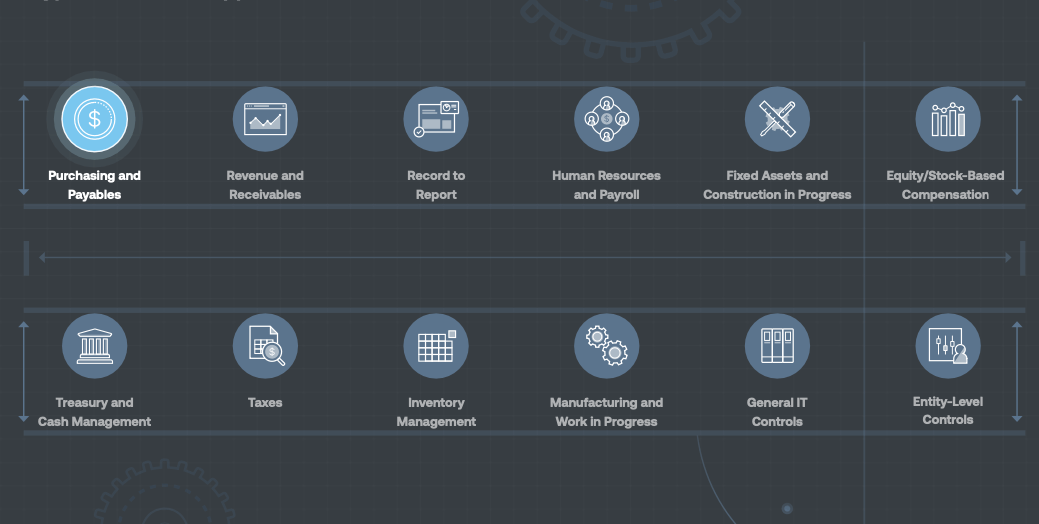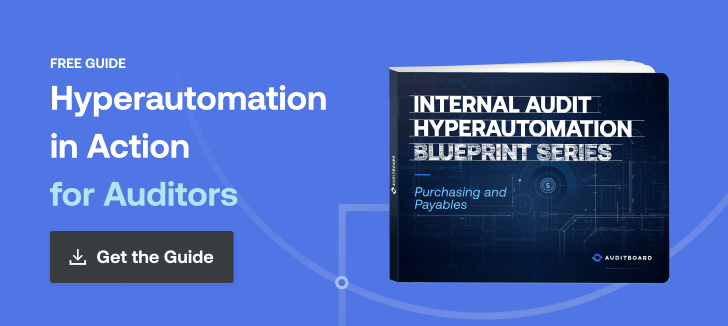
March 11, 2022 • 5 min read
Introduction to Hyperautomation for Auditors
Gartner defines hyperautomation as “a business-driven, disciplined approach that organizations use to rapidly identify, vet, and automate as many business and IT processes as possible.” Hyperautomation involves the orchestrated use of multiple technologies — e.g., robotic process automation (RPA), advanced analytics, low-code/no-code application platforms — to scale automation initiatives. The rapid rise of hyperautomation in the last several years indicates a shift from basic, task-centric automation — enabled by stand-alone, non-integrated solutions like RPA, process mining, and machine learning (ML) — toward process-level automation and process orchestrations.
The trend toward hyperautomation may seem daunting for audit teams who have only recently implemented automation technologies like RPA and audit analytics solutions. In a 2022 Gartner survey, 56% of CAEs identified moving to advanced analytics as an extremely important issue for them. Thankfully, adopting hyperautomation in your audit processes is extremely feasible. Hyperautomation-enabling solutions are being rapidly adopted by auditors due to their accessibility, intuitiveness, ease of automation, and simple integration — as well as their ability to extract, process, analyze, and visualize large amounts of audit data.
Our Internal Audit Hyperautomation Blueprint Series, explores examples of business processes typically selected for SOX and internal audit testing that contain many opportunities for hyperautomation. Download your free copy of our first whitepaper in this series — which examines analytics and automation opportunities across the purchasing and payable lifecycle — and read on below to learn more about the rise of hyperautomation.
The Rise of Hyperautomation
The journey to hyperautomation began with the introduction of standalone RPA solutions that enabled the achievement of manual and repetitive tasks. Thanks to their quick implementation time, RPA solutions took off and RPA soon became one of the most clearly defined subsets of the hyperautomation market. In addition, other hyperautomation-enabling technologies rapidly developed alongside RPA, including:
- Advanced analytics: The autonomous or semi-autonomous examination of data or content using sophisticated techniques and tools, typically beyond those of traditional business intelligence (BI), to discover deeper insights, make predictions, or generate recommendations.
- Augmented analytics: The use of ML/AI techniques to transform how insights from analytics are developed, consumed, and shared. Augmented analytics enable users without advanced skills to interact with data and insights, helping to augment human business decisions.
- Low-code/no-code application platforms (LCAP): Applications that only require text entry for formulas or simple expressions.
- Software-as-a-service (SaaS): Software that is owned, delivered, and managed remotely by one or more providers.All of the major SaaS vendors currently provide capabilities that incorporate low-code development technologies.
This brings us to the present, where hyperautomation aims to bring together and tightly integrate these separate automation technologies, enabling process-level automation and orchestration.
Where can hyperautomation fit in your day-to-day routine? The following are twelve examples of business processes typically selected for SOX and internal audit testing that contain ample opportunities for hyperautomation.

For an example of what process-level automation looks like for internal auditors with hyperautomation, download our whitepaper: Internal Audit Hyperautomation Blueprint: Purchasing and Payables. This first installment in our series will explore the most impactful automation opportunities in the purchasing and payables lifecycle, including value-add focused procedures for discovery analytics and data profiling, as well as fraud and internal control automated analysis and testing techniques. An overview of the typical systems and data files used is included as well.
Stay tuned for further installments of our Internal Audit and Hyperautomation Blueprint Series that will explore opportunities across other SOX and audit business processes.
You may also like to read


Top headlines that defined 2025 for internal auditors

Master your audit playbook: essential steps for internal audit teams

How the C-suite views risks and opportunities in 2026: are internal auditors poised to help?

Top headlines that defined 2025 for internal auditors

Master your audit playbook: essential steps for internal audit teams
Discover why industry leaders choose AuditBoard
SCHEDULE A DEMO





